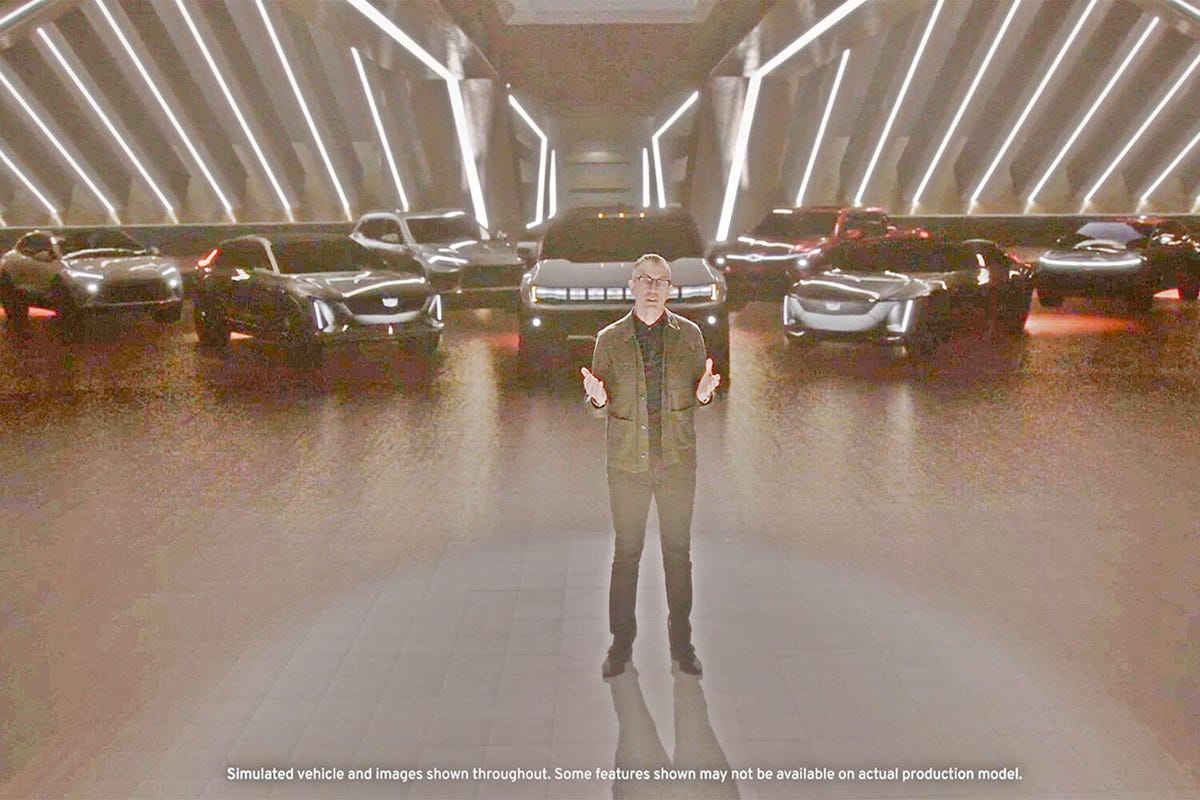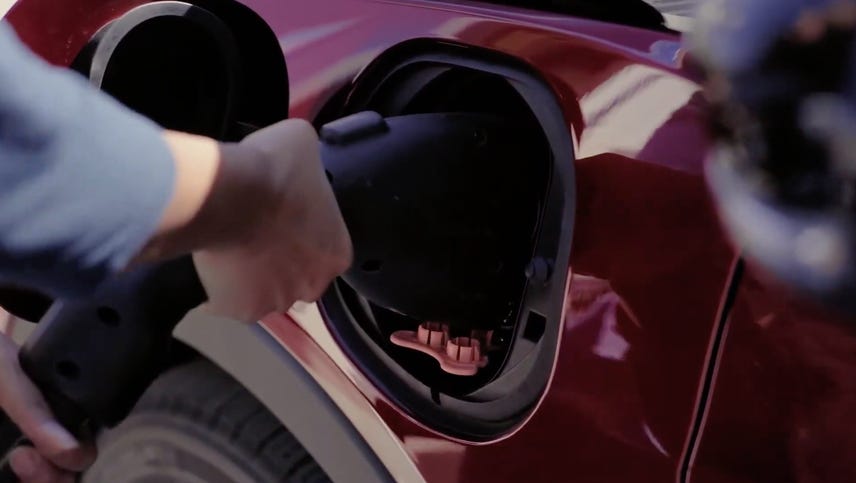
General Motors EV onslaught
General Motors went big at this year's all-digital CES, giving us a sneak peek at a number of future electric cars. We've lightened the photo here to give you a better look at what's coming down the road.
Cadillac eVTOL
GM surprised us with some renderings of a Cadillac-branded personal aircraft powered by batteries.
Cadillac eVTOL
We don't have many details, but Cadillac says this four-rotor aircraft is powered by a 90-kilowatt-hour electric motor and can reach speeds of up to 56 mph.
Cadillac eVTOL
Based on the images, the eVTOL looks like a single-seat drone, presumably for short urban hops executed autonomously. However, GM hasn't said when we can expect to see the real thing in the air.
Cadillac Celestiq EV
We only got a quick glimpse at the new Celestiq EV, but it got us wanting to see more.
Cadillac Celestiq EV
The Celestiq's dashboard will have a pillar-to-pillar screen that will give both front-seat occupants a whole lot of infotainment real estate.
Cadillac Celestiq EV
The Celestiq will have a four-part electrochromic glass roof, each capable of dimming to a different level.
Cadillac Halo
Cadillac showed off a fully autonomous concept pod car called the Halo.
Cadillac Halo
A wraparound couch fills the interior space and there's wood flooring, while the window shapes give off a midcentury modern vibe.
2022 Chevy Bolt EUV
Chevrolet confirmed the new Bolt EUV crossover will debut in February alongside a refreshed version of the standard Bolt EV hatchback.
2022 Chevy Bolt EUV
The best news? The Bolt EUV will offer General Motors' excellent Super Cruise hands-free highway driving assist technology.
GM BrightDrop EV600
General Motor also announced BrightDrop, a new logistics-focused business unit for the Detroit-based automaker, featuring the EV600 all-electric van.
GM BrightDrop EV600
The EV600 promises a driving range of up to 250 miles and more than 600 cubic feet of cargo space.
GM BrightDrop EP1
As part of the BrightDrop eco-system, GM also showed of the EP1 motorized pallet.
GM BrightDrop EP1
Think of the EP1 as a motorized box that can help couriers and logistics companies handle short-distance parcel transport, like moving boxes from a truck to a customer's door, or even moving items inside of a warehouse.
Mercedes-Benz MBUX Hyperscreen
If screens are your jam, check out the MBUX Hyperscreen, which features 56 inches of full color display for your eyeballs.
Mercedes-Benz MBUX Hyperscreen
The Hyperscreen will launch in the upcoming EQS electric sedan.
Mercedes-Benz MBUX Hyperscreen
The Hyperscreen is comprised of several individual displays mounted in a single glass-covered housing. This unified assembly stretches clear across the dashboard, nearly from one A pillar to the other, making it the interior's most prominent element.
Caterpillar Autonomous Truck
A virtual rendering of Caterpillar's enormous autonomous mining truck shows its scale at CES' all-virtual exposition.
Caterpillar Autonomous Truck
This massive truck is about as tall as a two-story house and weighs a staggering 284.6 tons when empty. Fully loaded, the Cat 797F can weigh up to 687.5 tons, or as much as 15 passenger planes. Yowza.
John Deere VR
John Deere built a VR demo of a planter on a farm.
John Deere VR
John Deere wants to make its virtual farming demo more immersive through virtual reality.
Gentex Mirror-Integrated DVR
Tired of a clunky old dashcam? Gentex showed of its mirror-integrated digital video recorder at CES.
Gentex Mirror-Integrated DVR
The integrated recording system can protect you after a crash and keep tabs on passengers. A built-in shock sensor can automatically start recording if someone hits your car.
Mobileye
Mobileye announced it will be working with Intel for a lidar system-on-a-chip (SoC) for use in autonomous vehicles by 2025.
Mobileye
This system, built using Intel's own silicon fabrication tech, puts both active and passive lidar elements on a single chip, eliminating the need for cameras and other machine-vision technologies.
Pioneer subwoofer
Pioneer went small with the TS-WX010A subwoofer at CES this year. It's designed to fit into small spaces in a car's cabin and not take up copious amounts of room in the trunk.
Pioneer subwoofer
Shown here tucked under a front seat, the TS-WX010A is just 9 inches wide, 4.6 inches deep and 2.7 inches thick.
Pioneer Nex car audio system
The Nex DMH-WC5700NEX audio system separates its LCD touchscreen from the main headunit for more flexible installation in modern cars.
Pioneer Nex car audio system
It features a 6.8-inch capacitive LCD touchscreen that mounts on the dashboard with a trim kit like any other car stereo receiver, but it's only about as thick as a chunky tablet.
Harman Automotive Experience
Harman developed three new "experience concepts" for inside your vehicle. Here we've got the Creator Studio, helping folks make and post content on the go.
Harman Automotive Experience
With high-resolution OLED and QLED displays, Gaming Intense Max supports up to three in-vehicle players as well as personal game data and subscriptions, all running on 5G.
Harman Automotive Experience
Drive-Live Concert is a concept that transforms your vehicle into a live music venue with a twist. Users can vote on the next song they want played or even interact with artists.
Indy Autonomous Challenge
Yep, we will soon have driverless cars racing around the famed oval in Indianapolis.
Indy Autonomous Challenge
The IAC car is based on the IL-15 chassis from Dallara, which is powered by a turbocharged four-cylinder engine. Each car is mechanically the same and it's the software that gives each team a competitive edge.
Indy Autonomous Challenge
The field will feature several dozen teams from engineering schools around the world with a prize of $1 million. Look for the race to take place on Oct. 23, 2021.
Panasonic wireless phone charger
Panasonic debuted a fancy-pants wireless phone charger at CES that actually moves to fit your smartphone better.
Panasonic wireless phone charger
The technology within the device is supposed to target a phone's charging coil more accurately, even if the device isn't sitting perfectly on it, resulting in faster charging times.
Mitsubishi MyQ garage door opener
Set to debut on the 2022 Mitsubishi Eclipse Cross, the MyQ garage door opener is accessed on the car's new 8-inch infotainment screen.

GM Ultifi
The new customer experience platform from GM is meant to give EV drivers a simplified ownership experience. Through a digital identification number and corresponding profile, owners will be able to manage all aspects of their EV, from charging to over-the-air updates.
FCA eVTOL
Archer Aviation announced that it will partner with Fiat Chrysler Automobiles to build an air taxi powered by a 187-kWh battery pack with 60 miles of range and a top speed of 150 mph.

